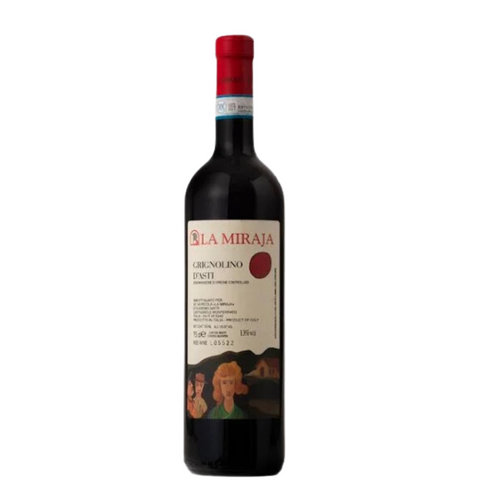
2023 La Miraja Grignolino d'Asti, Piedmont, Italy
Beautiful floral notes of rose hip, violet, and geranium. Delicate, bright red fruit dominated by bing cherry mingles with fresh mushroom. An underlying vein of stony minerality lends both texture and levity to this delightful bottling.
ABOUT THIS WINE
Grignolino was the favored red wine of the Savoy aristocracy in the thirteenth century, prized for its light color and elegant mouthfeel. In the latter half of the 1800s, these wines often matched or exceeded the price of Barolo bottlings. The grape name likely derived from the word “grigné,” which is the local dialect for the pips, or grape seeds. Grignolino is rare among its fellow wine grape cultivars in that it has multiple pips per berry. In addition, the thin, delicate skins of the berry pose a challenge for winemakers aspiring to pull as much color from the skins as possible while avoiding the extraction of oftentimes harsh, green tannins from the pips. Accomplishing this oenological hat trick can result in brilliantly aromatic and brightly acidic expressions of Grignolino.
Estate fruit from vineyards situated around 280 meters above sea level. Southwest exposure. Calcareous-red clay soils. Many vines were planted in 1960, others more recently. 5,000 vines per hectare trained in the guyot style. Only 70 quintals per hectare harvested. Hand-harvested fruit is destemmed and then crushed by basket press into stainless-steel tanks, where it remains in contact with the skins for 7 days while native fermentation occurs. Following spontaneous malolactic fermentation, the wine rests in cement vessels for several months prior to release.
ABOUT THIS PRODUCER
Nestled within the original castle of Castagnole Monferrato, La Miraja was constructed as an armory in the 11th century, only to be retrofitted as a cellar in the 1400s. In this armory-turned-cellar, Eugenio Gatti, a seventh-generation viticulturist, turns out Barbera, Grignolino, Freisa, and his fabled Ruché. His oldest Ruché plantings are located in the famed Majole vineyard, one of the first sites in Castagnole Monferrato where the grape was planted with the intention of producing single-varietal wines. Majole was replanted in the 1970s, and its Ruché vines rank among the oldest in the world. This has long been considered the top site of Castagnole Monferrato—the epicenter of Ruché production and the first of seven villages granted permission to produce single-varietal Ruché under the DOCG. La Miraja (pronounced “me-rye-uh”) is tiny by any measure, comprising less than 4 hectares under vine. It is here that Eugenio devotes his life’s work to producing roughly 2,500 transcendent cases of wine each year. Harnessing his years of working in wineries and distilleries across Italy, he imbues his wines with a haunting purity and a simple elegance.
Details:
| Grape(s) | Grignolino |
| Farming | Traditional |
